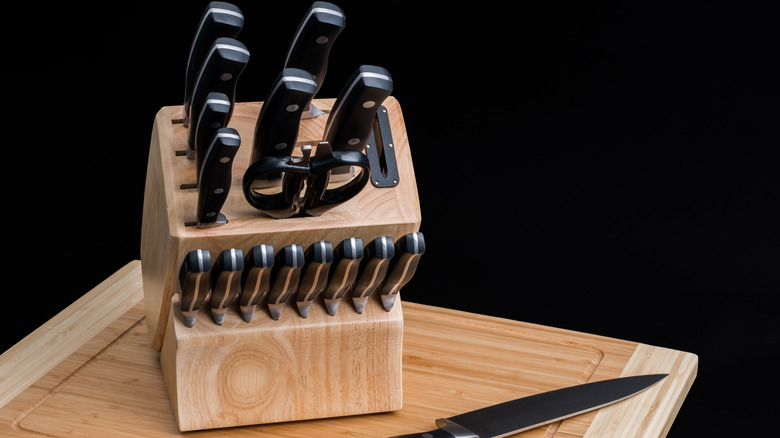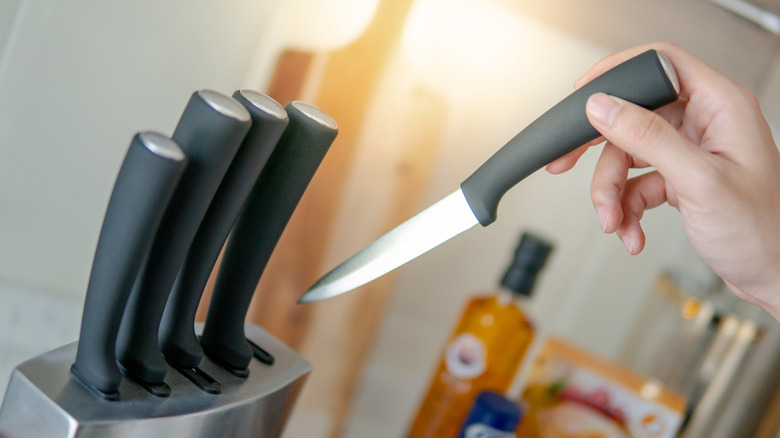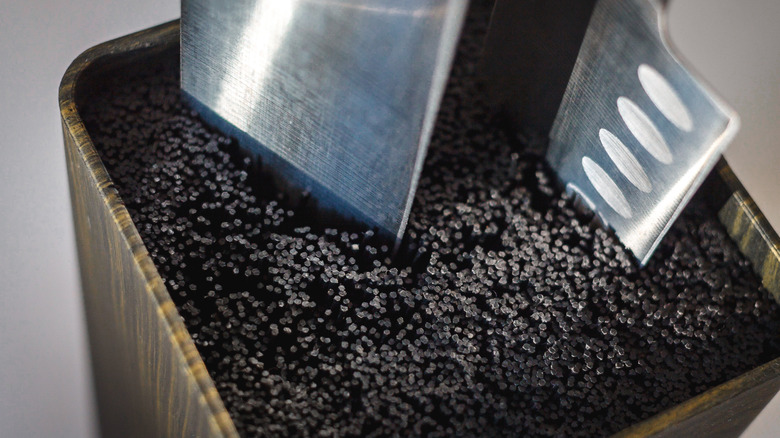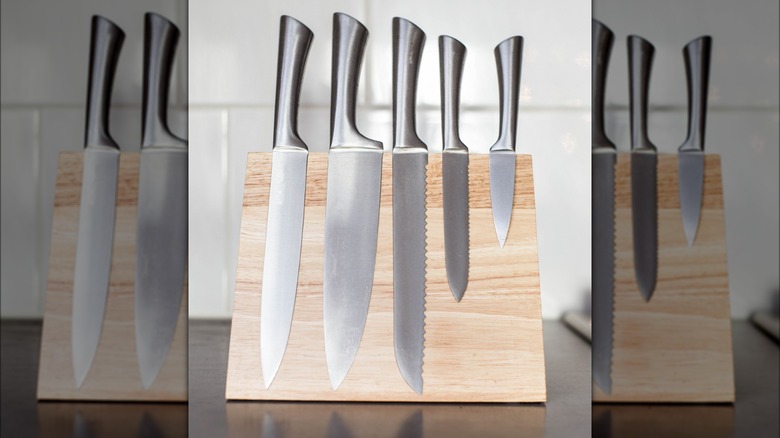How To Clean Every Crevice In Your Knife Block
A knife block is an easy item to overlook during regular deep cleans of your kitchen, but it definitely should make it into your rotation every four to six weeks. Depending on the type you have, the process can be as easy as a quick wipe down or a bit more finicky, including scrubbing, soaking, drying, and conditioning.
A knife block with individual slots for each knife is undoubtedly the most time-consuming to clean and tends to accumulate the most debris. A common fixture on many countertops, these are typically made of wood, which means you absolutely cannot put them in the dishwasher.
Start by removing all the knives, tip the whole block upside down, and knock out any crumbs and dust. You can try gently tapping the bottom with a small hammer or rolling pin to help it along. Then, take a pipe cleaner, reusable straw brush, or slim bottle brush and shove it in each slot to dislodge any crud. Now, scrub the whole knife block with a firm — but not abrasive — sponge, hot water, and gentle dish soap. Utilize your pipe cleaner again to scrub inside the knife slots.
Pat the block dry, tip it upside down, and allow it to air-dry fully, which will take at least 12 hours. A fan or blow dryer can help, but it may take up to a couple of days depending on the humidity where you live.
You are not done yet...
So you did the hard work of scrubbing your knife block clean, but now you need to sanitize it. Create a weak solution of water along with bleach, vinegar, or hydrogen peroxide — but not all three. Pick only one. Wipe down the outside thoroughly with the solution, and fill the slots up too. Let the liquid sit on the block for one minute, tip it out of the slots, and rinse the whole thing well. Finally, pat it dry with a clean towel. Allow the knife block to fully dry again before you put your cleaned knives back in. If it is not completely dry, you risk trapping moisture inside, which can create the perfect environment for mold to grow.
Now, if after all of this, the block looks dull, it may need to be conditioned with mineral oil. Put a small amount on a cloth, rub the knife block down, and then wipe off any residual oil with another clean cloth. After conditioning, you will need to allow another 12 hours to let it soak in. Run a final cloth over the block one more time to make sure you removed any unabsorbed oil before putting your knives back in.
How to clean other types of knife blocks
Follow the same steps for any wooden knife storage item — like a wooden or bamboo slotted drawer storage insert — including using oil to condition it. A plastic knife block or universal block with silicon slots should be regularly taken apart, scrubbed, and sanitized as well. They will take far less time to dry fully than their wooden counterparts and obviously will not have to be conditioned. Some of these may even be dishwasher safe — be sure to follow the care instructions provided by the manufacturer. The trade-off is that anything plastic probably will not last for nearly as long as wood.
The type of universal knife blocks that support the blade in hundreds of thin rods should be disassembled to clean. The rods are connected together at the base, so you won't be left with an unwieldy handful of synthetic spaghetti when you remove them. Some of these are dishwasher-safe (top rack, no heat dry) – though washing them by hand is probably a safer bet. These will also have to air-dry for at least 12 hours before reinserting them into the stand.
A better world does exist
To keep knife blocks as clean as possible, make sure your knives are spotless and fully dry before putting them away. You still should deep clean the knife block, but at least it won't get too gnarly.
With all the work it takes to clean knife blocks, you may be tempted to just chuck all your blades loose in a kitchen drawer — the one place you should never store knives. It seems like even pool noodles can help you store knives better than a block can. Don't sink into despair — there is another option.
Universal knife blocks that hold the blade by a magnet may be the answer to your woes. They allow you the flexibility to house knives of any size, and many models can be cleaned by simply wiping them off since there are no nooks and crannies for gunk to get stuck in.
A wooden magnetic knife block can usually just be dusted with a microfiber cloth. If it needs a deeper clean, treat as you would other wooden items — wipe it down with soapy water, follow it up with a cloth dampened with clean water, and then pat (and air) dry. Depending on the exact material, use soap and water, rubbing alcohol, or baking soda and water to clean metal magnetic knife-holding strips. Since you really only need three knives in your kitchen arsenal, you may even want to skip the blocks entirely and opt for individual knife sheaths instead.




